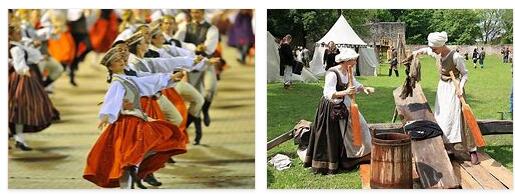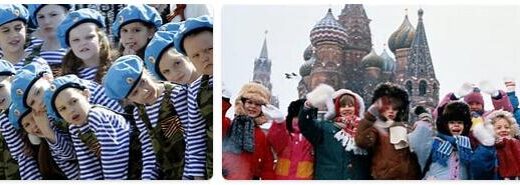Germany Encyclopedia for Kids
Germany
The industrial power of Europe
The economic heart of the European Union, a populous country with a strong identity and a great cultural tradition, Germany is one of the points of reference for Europe and the entire West: today, after reunification, also from a political point of view. With a turbulent and painful past behind it, Germany has embarked on the path of European unity, towards which it has encouraged other Central European countries, while still working hard to reduce the development differences within it.
From Upper to Lower Germany
Stretching between the North Sea and the Baltic Sea and the Alps, the territory of Germany is very varied, even if for the most part it is flat or slightly hilly, since it falls within the great plain that covers all of northern Europe. The variety of the territory and therefore of the German landscape is produced by the great heterogeneity of rocks and shapes of the relief, from the oldest to the most recent: in Germany there are traces of all European geological history, and the presence of ancient rocks, for example, explains the abundance of useful minerals.
The Alpine and Pre-Alpine mountains only concern the southern end of Germany, on the border with Switzerland and Austria; the highest peak in Germany is the Zugspitze (2,962 m). Other, less high mountains (Šumava and Ore Mountains) are those along the border with the Czech Republic and those (Black Forest, Swabian Jura) in south-eastern Germany.
Between these mountains, in the south of the country, the Swabian-Bavarian Plateau opens up, where the high Danube flows from west to east ; further north is the Franconian Basin, crossed by the Main and closed to the west, to the north (Thuringian Forest) and to the south (Franconian Jura) by wooded reliefs. To the north of these reliefs there are various hill formations, which rarely exceed 1,000 m. Further north, the German Lowland extends to the sea, crossed by large rivers such as the Ems, the Weser and the Elbe, and partly marshy, then forming a low and sandy coast on the North Sea, higher and higher rock on the Baltic Sea. Finally, along almost the entire western edge of Germany, the Rhine flows towards the North Sea in a wide valley, gathering many tributaries, including the Moselle.
In large part the German territory was strongly shaped by the glaciations, and the hills, the lakes, the valleys often show the effects of glacialism.
The prevailing climate is temperate and humid, but in the eastern regions it is continental, with strong seasonal differences.
The largest people in Western Europe
The German population is very dense, on average, but in reality it is distributed in a different way according to the regions. The greatest concentration occurs along almost the entire course of the Rhine, where important cities (the main ones are Stuttgart, Mannheim, Frankfurt am Main, Cologne, Düsseldorf and Essen, but there are many others) arise close to each other and have formed a ‘ megalopolis extended for some hundreds of kilometers. Another important urban concentration stretches between Dresden and Hanover.
Germany is a land of cities (the urban population is about 88% of the total): in addition to the capital, Berlin, we must also remember Leipzig, Hamburg and Bremen and many medium and small cities, a bit like in Italy. In the eastern regions, especially along the Baltic Sea, the population density is less, as well as in the south of the country (Bavaria, Franconia and Hesse), where, however, the cities are numerous, although not very large, apart from Munich.
Such a large and dense population was initially supported by agriculture, but above all by strong industrial growth from the mid-nineteenth century onwards. The strongest increase, however, was that produced by the return to Germany, after the Second World War, of at least 35 million Germans who had lived for centuries in regions of Eastern Europe (Czech Republic, Poland, Russia, Romania and elsewhere. ), from where they were expelled.
This sudden growth created many difficulties for Germany at first, but the industrial recovery that began in the 1960s even made it possible to attract immigrants from abroad (Italy, Turkey, Yugoslavia, Greece, Spain): today foreigners are about 9% of the population.
The last wave of migration was internal: after the reunification of the two Germanys (1990), in fact, many Germans moved from the eastern regions to the richer ones in the west.
The standard of living throughout Germany is high, and education and health conditions are excellent.
The country of big industry
Germany produces 7% of the wealth of the Earth and is the third largest economic power in the world. The main part of this wealth was produced by industry between the nineteenth and twentieth centuries; today, however, the activities of the tertiary sector count more, as in all advanced countries.
Traditional German agriculture was not very rich and varied, apart from regions such as the Rhine valley and some reclaimed northern areas, but it was conducted in a rational and productive way, especially in recent decades, closely associating it with cattle and pig breeding.
The presence of metals (silver, iron) and coal and lignite, on the other hand, allowed an early manufacturing development – already in the Middle Ages, along the Rhine – and industrial – first still along the Rhine, used, with many other rivers and canals, as a transport route: the Rhine is still the busiest river in the world today. As early as the nineteenth century, but especially after the Second World War, the industry has spread a little throughout the country. The traditionally most important sectors are the chemical one, with companies of global importance, and the mechanical one: the automotive sector is the first in Europe, precision mechanics is very famous everywhere. But also the steel, electrotechnical, electronic, textile and food productions are of great importance.
Commercial and financial activities have also been very lively since the Middle Ages: at that time Germany was a transit area for trade between the Mediterranean (Italy) and the North Sea (Flanders), and the flourishing of cities along the Danube and the Rhine testifies to the wealth of those traffics, facilitated by the river routes – along which the railways and highways also run today. The increase in production and wealth then led to the accumulation of capital which made the Frankfurt stock exchange one of the most important financial centers in the world, and the mark, the currency circulating in Germany before the euro, one of the strongest..
The future between East and West
Germany is also a beautiful country, where the most modern achievements, in communications, industry and construction, have not stifled the care for traditions and rural landscapes.
Despite the destructions of the last war, the country still has very interesting monuments and works of art and cities, even if foreign tourists are not very numerous.
The proverbial ability of the Germans to organize does not translate into a boring and monotonous life: on the contrary, especially in certain regions – such as in the Rhineland and Bavaria – there is a great liveliness.
The determination of the German people in the face of difficulties is admirable, as we have seen again after the reunification. After 1990, the western regions supported the development of the eastern ones to bring them to their same level of well-being: Berlin has thus become a very modern city, emigration from the East has stopped, the enlargement of the European Union has transformed the Eastern Germany in a crucial and very dynamic area.



